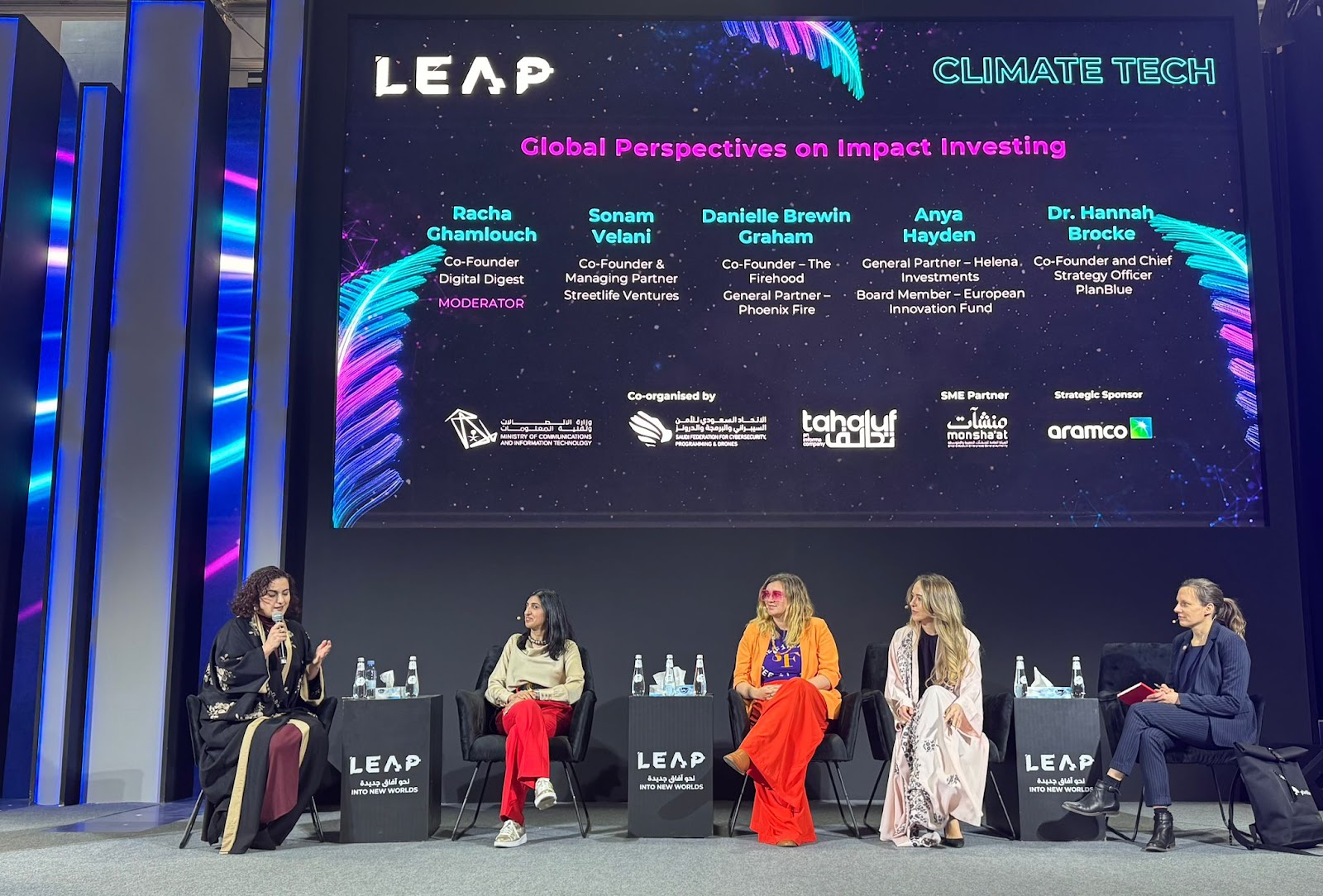
At LEAP'25 in Riyadh, Saudi Arabia, I had the privilege of speaking on the Climate Tech Stage, where I discussed the intersection of impact investing and sustainable technologies. The panel focused on how regional investment trends, market synergies, and local strategies can accelerate innovations that address climate change, and the ways in which impact investing can generate both social and financial returns.
As an Advisor for ventureLAB, the Co-Founder of The Firehood and General Partner at Phoenix Fire, we champion women-led startups that address critical issues like climate action and gender equality. Our focus is on increasing women entrepreneurs’ access to capital, and we partner with BDC, Canada's most active investor and the first Canadian bank to receive B Corp certification. With funds like BDC's $500M women-focused investment fund and their cleantech-specific fund, we’ve seen firsthand that intersectional investments in gender and climate are essential to building a sustainable future.
What Is Impact Investing?
Impact investing goes beyond charity—it's about creating measurable social and environmental impact while generating financial returns. It’s not a choice between "doing good" and "doing well." Impact investors should, and can, expect both. By backing women-led ventures in climate tech, AI, and sustainable solutions, we prove that diverse teams deliver better outcomes, both financially and socially. Our portfolio is full of such ventures that demonstrate the power of this dual impact.
Impact investing is often misunderstood as requiring a trade-off between growth and impact. In Canada, we navigate this by integrating both ESG and impact measurements—distinct yet complementary frameworks. Globally, different markets take varied approaches: Europe follows regulatory-driven frameworks like the EU Green Deal, while North America relies more on private capital.
At The Firehood, we measure success through both financial and impact metrics. Our financial metrics include revenue growth, market scalability, and investor interest, while our impact metrics include CO2 reduction, resource efficiency, and community benefits. Additionally, we incorporate gender-lens investing, measuring leadership diversity and improved access to capital for women founders.
Ultimately, impact and growth are not mutually exclusive. Without the ability to scale, a venture’s impact remains limited. True success lies in achieving both.
The Role of AI in Impact Investing & Climate Tech
AI offers exciting opportunities for both efficiency and environmental impact, but it also brings challenges, such as high energy consumption. Companies like Xatoms, which uses AI for water purification, show us how AI can be leveraged for good. However, impact investors must be mindful of AI’s carbon footprint. That’s why we prioritize investments in clean energy-powered AI models and energy-efficient data centers to mitigate its environmental impact.
Navigating Global Regulatory & Incentive Structures
The regulatory landscape varies significantly by region. Europe offers strong subsidies and incentives, North America is increasingly supporting green tech through tax credits and venture capital, and MENA (Middle East and North Africa) is rapidly advancing its green tech policies. At The Firehood, we work closely with local partners like BDC and global organizations to help our portfolio startups navigate these regulations abroad and access market opportunities.
Collaboration Between Traditional VCs and Impact Investors
Traditional venture capitalists (VCs) are increasingly recognizing the financial viability of impact startups. To bridge the gap, we collaborate with VCs through deal flow sharing, due diligence and by encouraging them to integrate impact metrics into their due diligence processes. We provide de-risked capital that helps attract follow-on investment, showcasing how integrating impact creates long-term value. Through collaborations with funds like BDC, which understands both financial and impact-driven outcomes, we strive to make impact investing more mainstream.
Science-Driven Ventures and Long-Term Capital
Science-driven ventures and climate solutions require patient capital, with longer investment horizons of 7-10 years. These ventures need time to mature and scale. Our fund structures reflect this, and we take a blended capital approach by combining grants, angel investments in other categories, venture capital, and government support. We also focus on educating our LPs (Limited Partners) about long-term returns and the significant systemic change that climate solutions can bring.
Measuring & Standardizing Impact Metrics
Though there’s still work to be done, we’re making strides toward standardizing impact measurement. At The Firehood, we align our metrics with global frameworks like IRIS+ and ESG reporting. By tracking both carbon footprint reduction for climate tech startups and diversity/inclusion metrics for leadership teams, we aim to ensure transparency, accountability, and ultimately, real, systemic impact.
Exciting Technologies for the Future
Looking ahead, several emerging technologies have the potential to transform the climate tech landscape; AI, particularly energy-efficient applications, will play a major role in optimizing resource use while reducing emissions. Carbon capture and storage technologies are scaling rapidly, and innovations in sustainable food systems, such as lab-grown proteins like Opalia’s dairy alternatives, are reducing emissions associated with traditional livestock farming. Additionally, advancements in battery storage and renewable energy adoption, supported by companies such as Litus, will be critical, with ocean tech and industrial transformation also showing tremendous promise.

Final Thoughts
As I concluded on stage, the future of climate tech and impact investing lies in transformative technologies, driven by diverse teams and supported by patient, long-term capital. By championing women-led innovations, we can ensure that the solutions of tomorrow are not only sustainable but also inclusive.
Moving forward, collaboration across sectors and markets is essential, along with an unwavering commitment to scaling impactful, sustainable solutions. The future of impact investing isn’t just about where we deploy capital — it’s about who we empower to lead the change by focusing on the solutions.
Signing off from Riyadh, where the future of climate tech is more than a forecast.
- Danielle

